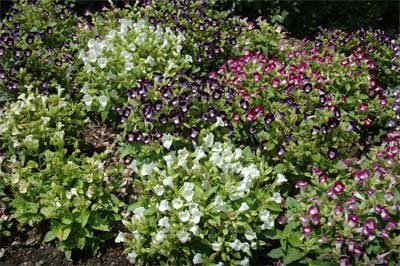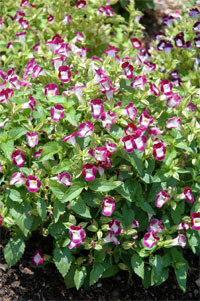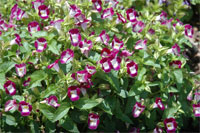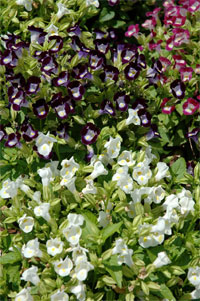Plant of the Month – May, 2012

Torenia fournieri ‘Kauai’ Mixed. All photos by Jimmy Turner.
Torenia ‘Kauai’ series

Torenia fournieri ‘Kauai’ Magenta

Torenia fournieri ‘Kauai’ Burgundy

Torenia fournieri ‘Kauai’ Mixed
AT A GLANCE
Latin name: Torenia fournieri ‘Kauai’ series
Common name: Wishbone flower
Flowers: 1” bicolor flowers
Mature size: 10” tall by 10” wide
Hardiness: Summer annual
Soil: Well-drained
Exposure: Light shade to full sun
Water usage: Medium
Sources: Local nurseries
This seed-grown annual surprised me last year – during a time officially known as the “hottest summer on record” in North Texas. In the past, I had relegated this plant to a group of early spring and shade plants only. Well, once again I was wrong. Last summer, ‘Kauai’ torenia flowered all summer long in part-sun and in shade. The plants that received morning sun actually flowered even better than those with all-day shade, and they flowered all summer, right up until first frost.
This torenia is non-spreading, so it will get only about 10 inches tall and 10 inches wide over the length of the season. There are seven colors and a mix available. The colors are Blue & White, Burgundy, Deep Blue, Lemon Drop, Magenta, Rose and White. I recommend planting in well-drained soil with at least some late-afternoon shade. They will perform well anywhere you would put impatiens or begonias for summer. You will find this torenia at local nurseries, most likely in 4-inch pots for bedding.
They are relatively maintenance-free, having no disease or pest problems we’ve discovered, and they don’t need any deadheading to stay attractive. I do find they need regular feeding with a high-nitrogen fertilizer to keep growing and flowering through the season.
If you’re curious why they are called “wishbone flowers,” take a close look at one of the flowers. You will find two stamens that are fused to look just like a little white wishbone in the center of the flower.
About the author: Jimmy Turner is the senior director of gardens at the Dallas Arboretum. Visit www.dallasplanttrials.org or more information on his trials.
